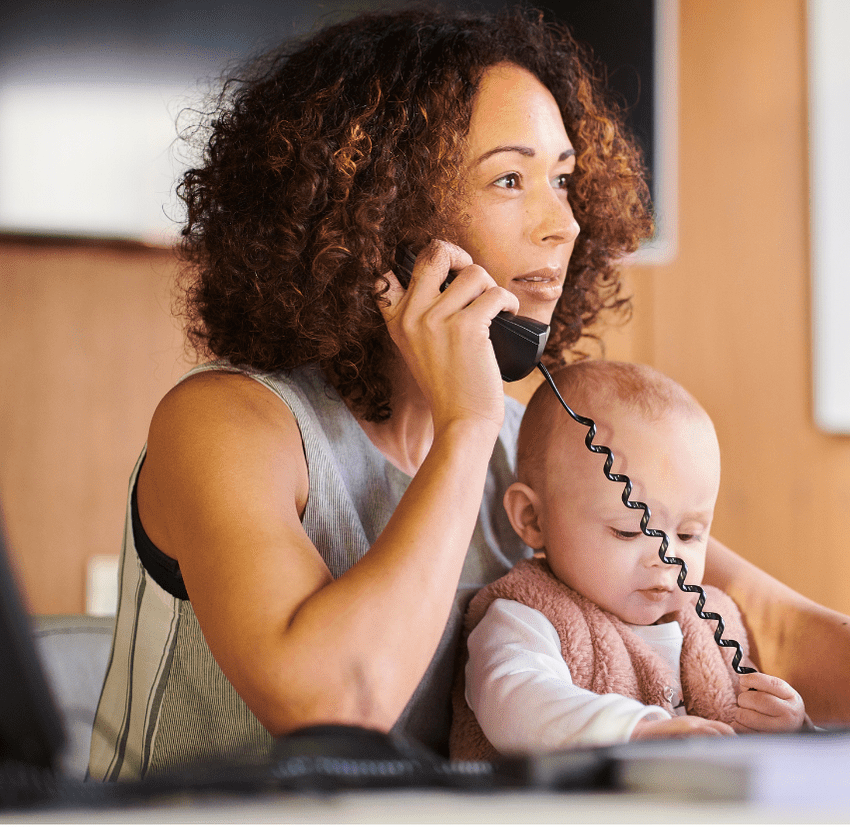Women at Work: The COVID work-life balance
Is remote working bad for women's rights?

Amidst the International Women’s Day celebrations last week, stories and reports emerged of the pandemic’s dire impact on women’s rights. Particularly the strain it has put on working mothers.
Studies have illustrated that when it comes to gender, women bore the economic brunt of the Covid-19 pandemic. Government-enforced remote working resulted in women taking up record levels of unpaid labour. This extra work paired with the gender pay gap led many women to adopt an unhealthy work-life balance or leave the workforce entirely.
For the most part, the reaction to the rise of remote work brought about by the covid pandemic has been positive. But is the excitement around working from home drowning out the voices of concern?
Does working from home really work for women? Early estimates are concerning with experts predicting the pandemic could set female equality back decades.
What has triggered the decline of women’s rights in the workplace and what can global businesses do to combat this?

Women at home
The pandemic has forced many women to juggle a multitude of professional and personal commitments – balancing working full time, childcare, and intensified domestic chores. Research shows that remote work and school closures resulted in women taking up the domestic work as their priority, leaving men free to prioritise the professional workload.
Across the globe, women previously spent an average of 4 hours 22 minutes per day on unpaid labour such as household chores and childcare. This figure is almost double the amount of time spent by their male counterparts. For women, the Covid pandemic has triggered this to rise to 6 hours and 30 minutes per day, an increase of almost 10%. In comparison, men have seen no average increase.
Women have also been negatively affected by global school closures and were twice as likely to take time off with no pay for childcare. UN studies illustrate that across the globe it was largely mothers who took up the bulk of home-schooling.
Natalie Clavijo, a professor from NEOMA Business School argues that the pressure to take on domestic work comes from internal forces as well as external factors:
“Even when women are the ‘breadwinners’ of the family, providing financial support to the rest of the family, their internalisation of their role as ‘caregivers’ is leading them to think that they are the ones who are supposed to take care of the children.”
Women who undertake the bulk of unpaid domestic or care work either spend less time engaged in paid labour or end up working longer hours to make up for the lost hours. Some working mothers claim they are conducting most of their professional work at night as their days are taken up by the strains of unpaid domestic labour.
The female workforce
Global data collected by UN Women theorizes that the Covid-19 pandemic could erase 25 years of hard-won gender parity.
The UN has also raised the alarm about the number of women leaving the workforce permanently. UN Women’s Deputy Executive Director Anita Bhatia told the BBC:
“In September alone, in the US, something like 865,000 women dropped out of the labour force compared to 200,000 men, and most of that can be explained by the fact that there was a care burden and there’s nobody else around.”
UN Women warns that the ripple effects of having fewer working women will negatively impact women across the world. This development will affect women’s mental wellbeing as well as general economic progress worldwide.
Women make up the bulk of the workforce for suspended industries such as beauty, tourism, childcare, and non-essential retail – leaving many female jobs under the protection of furlough schemes. When these schemes come to an end, this will inevitably trigger a significant drop in female employment.
For women in the United Kingdom, the furlough system meant taking a 20% pay cut on top of the pre-existing gender pay gap. The UK pay gap reporting was also cancelled in 2020, leading the Fawcett Society to raise concerns that the pandemic could widen the gender pay gap currently averaging at 15.9%.
The gender pay gap already leads many families to make financially motivated decisions when choosing which parent should stay at home. The pandemic has intensified this pressure on women as the pay gap paired with furlough pay cuts make them the financially logical choice for primary carer.
Stella Creasy, a British MP and equal pay campaigner argues that closing the gender pay gap will allow families the freedom to make this decision for themselves and will ultimately benefit men, women, children, and the wider workforce.
Workplace steps to gender equality
Despite being portrayed as a global equaliser, the social impact of the pandemic has been disproportionately felt by women. The virus has widened the unpaid labour gap between women and men, leaving women to prioritise unpaid work that is undervalued despite its multi-level societal importance.
Some employers have implemented flexible work schedules for working fathers and mothers, allowing parents more flexibility to share any childcare responsibilities. Where possible, these schemes also include other families in vulnerable situations such as single parents, widows, and extended households.
Promoting remote and flexible work policies for both genders is a key to combating the dual pressures of professional and domestic responsibilities affecting women in the workforce.
Additionally, supporting a healthy work-life balance for both genders will not only help gender parity but increase general productivity. Any focus on or investment in employee wellbeing will go a long way in the post-covid era.
A recent study by Mckinsey encouraged companies to look deeper when targeting stress and burnout in female employees. The study claimed that less than a third of global businesses adjusted performance review criteria to account for the challenges created by the pandemic. This means that many employees, especially female mothers and caregivers, risked falling short of pre-pandemic expectations or pushing themselves to keep up at an unsustainable pace.
Throughout the exit period and the aftermath of the pandemic, companies will need to make female employee wellbeing a priority if they want to combat the decline of women’s rights in the workplace.

Global payroll risk reduction: protecting your business as you scale
Reduce global payroll risk as you scale. Learn how to stay compliant, avoid costly errors, and protect your business across multiple countries.


How HR scales culture during global expansion
HR plays a crucial role in scaling company culture as businesses expand globally. Learn strategies to maintain engagement, align values, and support growth across borders.
